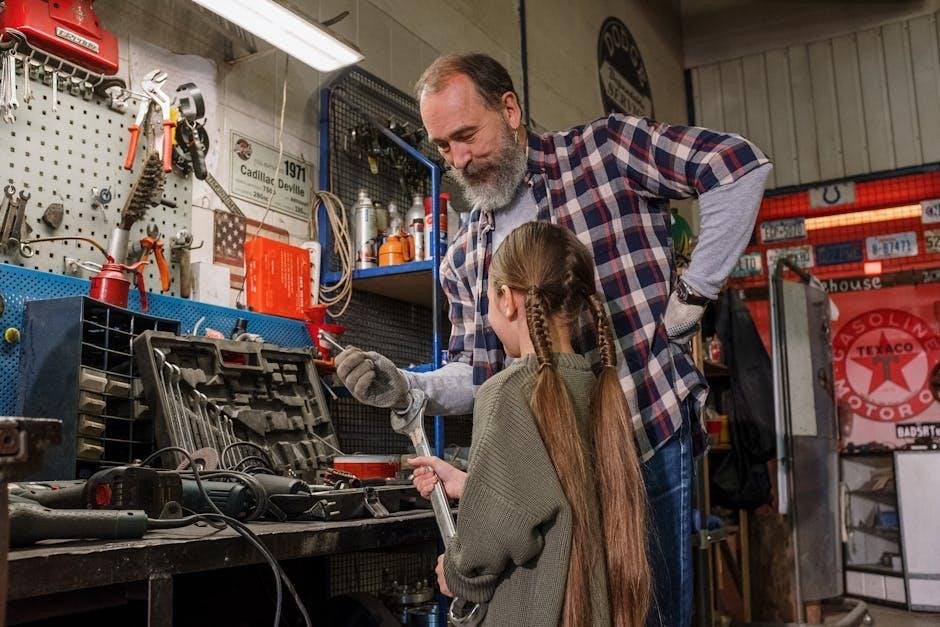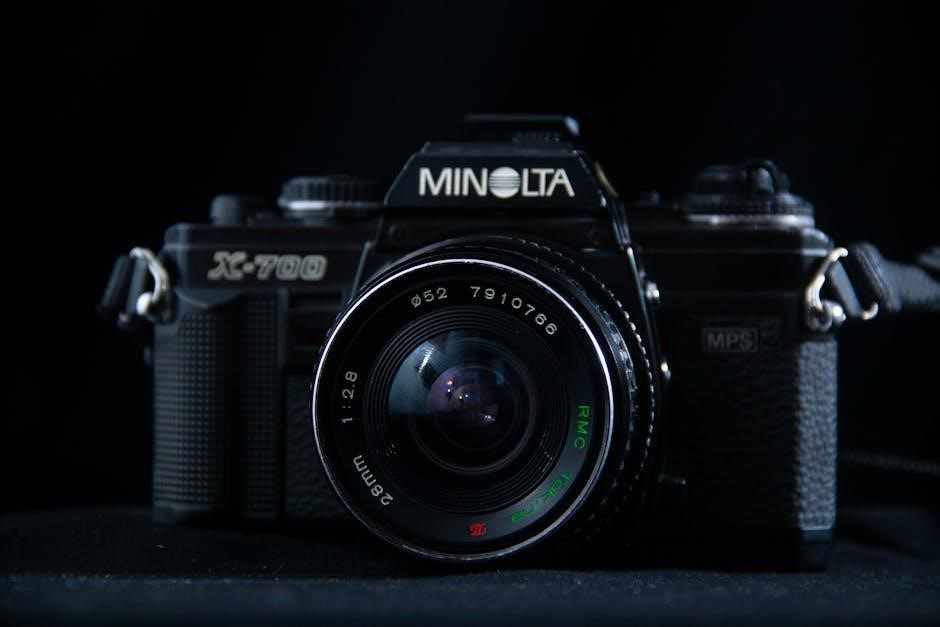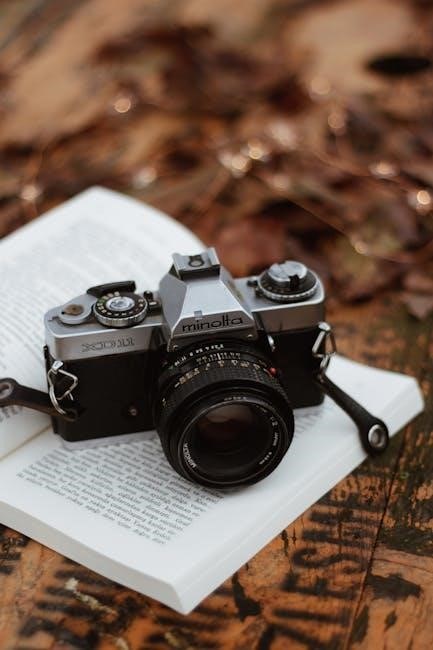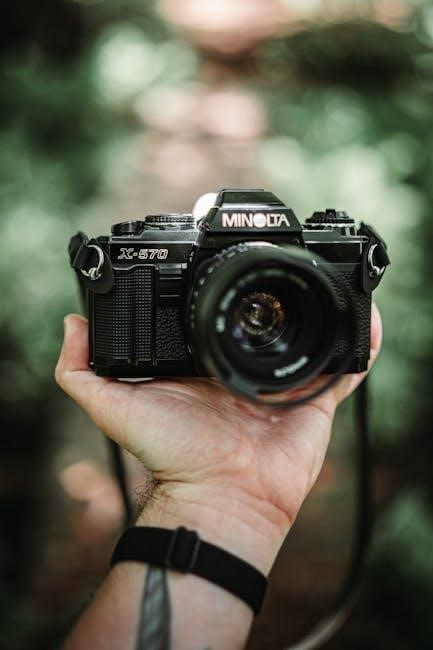
The Minolta SRT 201 instruction manual is a comprehensive guide for operating and understanding this classic 35mm SLR camera. It covers essential features, troubleshooting, and maintenance tips, ensuring photographers can maximize the camera’s capabilities. Available for free PDF download, the manual provides detailed insights into exposure settings, film loading, and creative control, making it an indispensable resource for both beginners and experienced users.
1.1 Overview of the Minolta SRT 201 Camera
The Minolta SRT 201 is a high-quality single-lens reflex (SLR) camera designed for photographers seeking precision and control. Known for its durability and reliability, it features manual focus and exposure control, allowing for creative freedom. The camera is compatible with a wide range of Minolta MC Rokkor lenses, offering versatility for various photography styles. Its built-in light meter ensures accurate exposure settings, while the intuitive design makes it accessible to both beginners and experienced photographers; The SRT 201 is part of the SR-T series, which has gained a reputation for excellence in film photography. With its robust construction and advanced features, the Minolta SRT 201 remains a favorite among photography enthusiasts. The instruction manual provides detailed guidance on optimizing its use, making it an essential companion for mastering this classic camera.
1.2 Importance of the Instruction Manual

The Minolta SRT 201 instruction manual is crucial for maximizing the camera’s potential and ensuring proper operation. It provides detailed guidance on film loading, focusing techniques, and exposure settings, which are essential for achieving high-quality photographs. The manual also covers troubleshooting common issues and maintenance tips to extend the camera’s lifespan. For photographers new to the SRT 201, the manual serves as a step-by-step guide to understanding its features, such as manual focus and aperture control. Advanced users will appreciate the insights into creative techniques and optimal use of compatible lenses. Available in PDF format, the manual is easily accessible and printable, making it a convenient resource for photographers of all skill levels. By following the manual, users can avoid errors, enhance their photography skills, and fully utilize the camera’s capabilities. Its comprehensive instructions ensure that every aspect of the Minolta SRT 201 is understood and utilized effectively.

1.3 Where to Download the Manual
The Minolta SRT 201 instruction manual is widely available for free download in PDF format from various online sources. Websites such as ManualsLib and cameramanuals.org provide direct links to the manual, ensuring easy access for users. Additionally, the M. Butkus library of camera manuals offers a comprehensive archive of Minolta manuals, including the SRT 201. Users can also find the manual on specialized photography forums and communities, where members often share resources. The manual is typically available as a combined guide for the SR-T 200, 201, and 202 models, so some sections may not apply to all versions. Downloading the manual is usually straightforward, with no registration required, though some sites may ask for basic user information. Once downloaded, the PDF format allows for easy viewing and printing, making it a convenient resource for photographers to reference anytime.

Key Features of the Minolta SRT 201
- Manual focus control for precise composition.
- Compatibility with Minolta lenses for versatile photography.
- Built-in light meter for accurate exposure settings.
- Aperture priority and manual modes for creative control.
2.1 Manual Focus and Exposure Control
The Minolta SRT 201 offers precise manual focus and exposure control, catering to photographers seeking creative command. Its manual focus system provides tactile feedback, allowing for exact composition. The camera features aperture priority and full manual modes, supported by a built-in light meter for accurate exposure readings. Users can adjust aperture and shutter speed independently, with the meter guiding optimal settings. The lens aperture ring and shutter speed dial are intuitively designed for quick adjustments. The MC Rokkor-X lenses, compatible with the SRT 201, further enhance focusing precision and image quality. A unique feature is the “stopped-down” metering, where the meter measures light through the lens at the selected aperture, ensuring accurate exposure calculations. This system is particularly useful for controlling depth of field and achieving desired artistic effects. The manual focus and exposure controls make the SRT 201 a versatile tool for photographers who value precision and creativity.
- Manual focus for precise control.
- Aperture priority and manual exposure modes.
- Built-in light meter for accurate readings.
- Compatibility with MC Rokkor-X lenses.
2.2 Compatibility with Minolta Lenses

The Minolta SRT 201 is designed to work seamlessly with a wide range of Minolta lenses, including the renowned MC and MD Rokkor series. Its SR mount system ensures compatibility with numerous lenses, from wide-angle to telephoto, providing photographers with versatile options for diverse shooting scenarios. The MC Rokkor-X lenses, known for their optical excellence, are fully compatible and offer exceptional image quality. Additionally, the camera supports older Minolta lenses, making it a flexible choice for photographers with existing collections. The manual focusing mechanism complements these lenses, allowing precise control over focus; With the SRT 201, users can explore various creative possibilities, leveraging the extensive range of Minolta optics to achieve professional-grade results. This compatibility ensures that the camera remains a valuable tool for photographers who appreciate the quality and legacy of Minolta glass.
- Compatible with MC and MD Rokkor lenses.
- SR mount system supports a broad range of optics.
- Works with both new and older Minolta lenses.
- Manual focusing enhances lens performance.
2.3 Built-in Light Meter and Exposure Settings
The Minolta SRT 201 features a built-in light meter that simplifies exposure control, offering precise measurements for optimal results. The camera utilizes a cadmium sulfide (CdS) light meter, which provides accurate readings for various lighting conditions. The meter is coupled with the camera’s aperture and shutter speed settings, allowing for seamless adjustments. Users can choose between manual mode for full creative control or aperture-priority mode, where the camera automatically adjusts the shutter speed based on the selected aperture. The light meter also supports exposure compensation, enabling photographers to fine-tune their settings for challenging lighting scenarios. The manual highlights the importance of understanding the interplay between aperture, shutter speed, and ISO to achieve desired effects. With its robust exposure system, the SRT 201 empowers photographers to capture images with exceptional clarity and artistic intent.
- Cadmium sulfide (CdS) light meter for accurate readings.
- Manual and aperture-priority modes for flexible control.
- Exposure compensation for adjusting to challenging lighting.
- Integration with aperture and shutter speed settings.
A key feature of the SRT 201 is its “match-needle” system, where the light meter and aperture/shutter speed dials are linked, making it easy to achieve proper exposure. This system ensures that photographers can focus on composition and creativity while relying on the camera’s precise mechanics. The manual also provides guidance on interpreting meter readings and making adjustments for various lighting conditions, including low-light and high-contrast scenes. Whether shooting in black-and-white or color, the SRT 201’s exposure system delivers consistent results, making it a trusted tool for both amateur and professional photographers.
For optimal results, ensure the camera’s battery is fresh, as the light meter relies on power to function accurately.

Camera Components and Accessories
The Minolta SRT 201 includes essential components like the MC Rokkor lenses, viewfinder, and focusing screen. Accessories such as remote shutters, lens hoods, and filters enhance functionality and creativity for photographers.
3.1 Lens Compatibility and Mount System
The Minolta SRT 201 is compatible with a wide range of lenses, including the renowned MC Rokkor series, which offers exceptional optical quality. The camera features the SR mount system, ensuring seamless compatibility with various Minolta lenses. This versatility allows photographers to choose from standard, wide-angle, telephoto, and specialized lenses, catering to diverse shooting needs. The manual provides detailed guidance on lens mounting, ensuring proper alignment and secure attachment. It also highlights the importance of using compatible accessories to maintain optimal performance. With its robust mount system, the SRT 201 supports a vast array of creative possibilities, making it a versatile tool for both amateur and professional photographers.
3.2 Viewfinder and Focusing Screen
The Minolta SRT 201 features a bright and accurate viewfinder with 97% frame coverage, providing photographers with a clear and precise view of their subject. The viewfinder includes a split-image microprism focusing aid, which simplifies manual focusing by splitting the image when it is out of focus. This feature ensures sharp images even in challenging lighting conditions. Additionally, the camera is equipped with a full-area metering system, which works in conjunction with the viewfinder to deliver accurate exposure readings. The focusing screen is interchangeable, allowing photographers to adapt to different shooting scenarios, such as macro or wide-angle photography; The manual emphasizes the importance of maintaining the viewfinder and focusing screen, offering tips on cleaning and care to preserve their functionality. These features collectively enhance the shooting experience, making the SRT 201 a reliable choice for photographers seeking precision and control. The combination of advanced optics and user-friendly design ensures optimal performance for various photographic applications.

Operating the Minolta SRT 201
The Minolta SRT 201 instruction manual provides detailed guidance on essential camera operations, including film loading, advance mechanisms, and focusing techniques. It also covers setting aperture and shutter speed for precise exposure control, ensuring photographers can master the camera’s functionality effectively.
4.1 Film Loading and Advance
Properly loading and advancing film is crucial for optimal performance of the Minolta SRT 201. The instruction manual provides step-by-step guidance on how to load 35mm film into the camera. First, open the camera back by pulling the film release lever located on the bottom. Next, insert the film cartridge into the film chamber, ensuring it is securely seated. Align the film’s leading edge with the take-up spool and gently advance the film using the manual advance lever. Close the camera back and ensure it clicks into place to confirm it is properly sealed. The manual emphasizes the importance of advancing the film correctly to avoid exposure issues. Once loaded, use the film advance lever to move to the first frame. The manual also explains how to rewind the film when finished, ensuring no light exposure during the process. By following these steps, photographers can ensure their film is loaded and advanced correctly, ready for shooting. The manual’s clear instructions make this process straightforward for both new and experienced users. Proper film handling is essential to achieve the best results with the Minolta SRT 201.
4;2 Focusing Techniques
Focusing techniques are essential for achieving sharp and precise images with the Minolta SRT 201. The manual highlights the camera’s manual focus operation, emphasizing the importance of using the focusing ring on the lens. By rotating the ring, photographers can adjust the focus to ensure their subject is clear. The manual also explains the use of the camera’s viewfinder, which features a microprism spot and a split-image focuser to assist in achieving accurate focus. These tools help users quickly determine when their subject is in sharp focus. The instruction manual provides tips for focusing in various lighting conditions and for different types of subjects, such as portraits or landscapes. It also advises on using the depth of field preview button to check the focus range before taking a shot. Proper focusing techniques ensure that every image captured is crisp and well-defined, making the most of the Minolta SRT 201’s capabilities. By following the manual’s guidance, photographers can master the art of manual focusing and produce high-quality results consistently.
4.3 Setting Aperture and Shutter Speed
Setting aperture and shutter speed on the Minolta SRT 201 is a straightforward process that allows photographers to control exposure and achieve their desired creative effects. The manual explains that aperture is adjusted using the aperture ring on the lens, while shutter speed is set using the shutter speed dial located on the camera’s top plate. Both settings are clearly marked, making it easy to select the desired values. The manual emphasizes the relationship between aperture and shutter speed, noting that they work together to determine the overall exposure. Users can choose from a wide range of aperture settings, typically from f/1.4 to f/16, and shutter speeds from B (bulb) to 1/1000 of a second. The manual also provides guidance on using the camera’s built-in light meter to ensure accurate exposures. By mastering these controls, photographers can optimize their images for various lighting conditions and artistic goals. The manual’s clear instructions make it easy for both beginners and experienced photographers to understand and utilize these fundamental settings effectively.

Advanced Techniques and Modes
The Minolta SRT 201 offers advanced techniques like manual mode for creative control, enabling photographers to experiment with precise exposures. It also covers depth of field, composition, and using flash for dynamic lighting effects, enhancing artistic expression in photography.
5.1 Manual Mode and Creative Control
Manual mode on the Minolta SRT 201 offers photographers full creative control over exposure settings, allowing for precise adjustments to aperture, shutter speed, and film sensitivity. This mode is ideal for capturing unique lighting conditions or achieving specific artistic effects. The camera’s built-in light meter provides accurate exposure readings, guiding photographers in making informed decisions. With manual control, users can experiment with depth of field, motion blur, and contrast, unlocking the full potential of their photography. The manual also includes tips for optimizing creative techniques, such as adjusting the aperture to isolate subjects or using slower shutter speeds to convey movement. By mastering manual mode, photographers can elevate their work, ensuring every shot meets their vision. The Minolta SRT 201 instruction manual further enhances this experience by offering detailed guidance on advanced shooting strategies and troubleshooting common challenges, making it an invaluable resource for both enthusiasts and professionals.

5.2 Using Flash and External Lighting
Using flash and external lighting with the Minolta SRT 201 enhances your photography by providing additional illumination and creative control. The camera supports various flash units, including the Minolta Auto Electro Flash, which synchronizes seamlessly with the shutter. The manual explains how to set the flash mode, adjust flash intensity, and balance it with ambient light for natural-looking results. External lighting options, such as studio strobes or continuous lights, can also be integrated to achieve professional-grade images. The Minolta SRT 201 instruction manual offers tips on positioning lights, using reflectors, and diffusing harsh shadows to optimize your shots. It also covers troubleshooting common flash-related issues, such as overexposure or underexposure, by guiding users to adjust settings like aperture and shutter speed. By mastering flash and external lighting techniques, photographers can expand their creative possibilities, ensuring well-lit and visually striking photographs in various conditions. The manual’s detailed guidance makes it easier to explore advanced lighting setups and achieve desired effects with precision.
5.3 Depth of Field and Composition
The Minolta SRT 201 instruction manual emphasizes the importance of depth of field and composition in capturing professional-quality images. Depth of field refers to the area in focus within a photograph, and the manual explains how to control it using aperture settings. By adjusting the aperture, photographers can isolate subjects or ensure entire scenes are sharp. The manual also provides guidance on composition techniques, such as the rule of thirds, leading lines, and framing, to create visually appealing images. It highlights how the camera’s viewfinder and focusing screen can aid in precise composition. Additionally, the manual offers tips on experimenting with different angles and perspectives to add creativity to your shots. Understanding depth of field and composition is crucial for making the most of the SRT 201’s capabilities, and the manual’s insights help photographers refine their skills. By mastering these concepts, users can produce images with both technical precision and artistic flair, ensuring their photography stands out. The manual’s detailed explanations make it easier to explore these creative aspects and achieve desired visual effects.

Maintenance and Troubleshooting
Regular maintenance ensures the Minolta SRT 201 operates optimally. Clean the camera and lens to prevent damage and ensure sharp images. The manual provides solutions for common issues, such as jammed film or faulty light meters, to keep your camera functioning smoothly.
6.1 Cleaning the Camera and Lens
Cleaning the Minolta SRT 201 and its lens is essential for maintaining image quality and prolonging the camera’s lifespan. Use a soft, dry cloth or a microfiber brush to gently remove dust and debris from the camera body and viewfinder. For the lens, apply a few drops of lens cleaning solution to a microfiber cloth, then wipe in a circular motion, avoiding harsh pressure that could scratch the glass. Never use household chemicals or abrasive materials, as they may damage the lens coating or camera surfaces. Regular cleaning prevents smudges and dust from affecting your photos. The instruction manual provides detailed guidance on proper cleaning techniques and recommends using high-quality cleaning solutions and tools to ensure optimal results. By following these maintenance steps, you can keep your Minolta SRT 201 in excellent condition and ensure sharp, clear images for years to come.
6.2 Common Issues and Solutions
The Minolta SRT 201, like any mechanical camera, may encounter issues over time. One common problem is inaccurate light meter readings, often resolved by cleaning the meter or adjusting its calibration. Another issue is the shutter sticking or failing to advance, which can be addressed by cleaning the mechanical components or replacing worn parts. Lens fogging or condensation, especially in humid environments, can be mitigated by using a silica gel packet or allowing the camera to acclimate to temperature changes slowly. If the film advance becomes jammed, gently rewinding the film and checking for obstructions usually resolves the problem. The instruction manual provides troubleshooting tips and maintenance advice to address these issues effectively. Regular servicing and proper care can prevent many of these problems, ensuring the camera continues to function reliably. Always refer to the manual for specific guidance on diagnosing and resolving common issues to maintain optimal performance.
The Minolta SRT 201 instruction manual serves as an essential guide for photographers seeking to master this classic 35mm SLR camera. By detailing its features, operation, and maintenance, the manual empowers users to unlock the camera’s full potential. From film loading and exposure settings to advanced techniques like depth of field control and flash photography, the manual provides clear, step-by-step instructions. Its troubleshooting section further ensures that common issues can be resolved efficiently, extending the camera’s lifespan. Available in PDF format, the manual is easily accessible, making it a vital resource for both beginners and seasoned photographers. The Minolta SRT 201 remains a beloved choice for its durability, manual control, and creative versatility. With the manual as a companion, photographers can continue to capture timeless moments with precision and artistry.